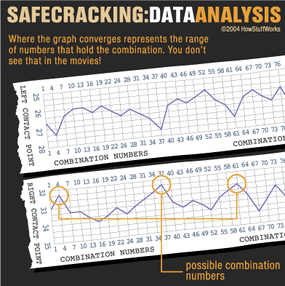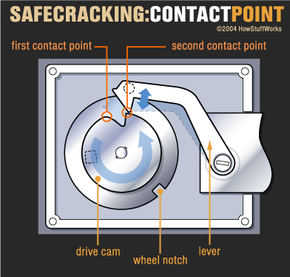Lock Manipulation
Lock manipulation requires a certain level of acumen that other methods of safecracking do not. You may be familiar with the concept of taking either the high or low road. Among many safecrackers, lock manipulation is considered to be "taking the high road." This is because lock manipulation represents safecracking at its most pure form. Technically, lock manipulation is the process of opening a locked safe without drilling or defacing the safe in any way. As the name implies, you use the lock against itself to discover the combination.
This method is ideal because it requires few, if any, tools and is, by far, the most discreet way to crack a safe. It does, however, require tremendous patience. The safecracker must also possess a clear understanding of the mechanical actions of locks in the various forms they take and/or some knowledge of the characteristics of the safe owner.
Advertisement
The art of lock manipulation is based largely on the scientific approach created in 1940 by Harry C. Miller. Just as in the movies, the safecracker uses sound to discover the combination. But what you don't see in the movies is that a safecracker needs more than a few seconds and a good ear to pull it off.
Miller put forth a three-step process to manipulate the lock into revealing its combination:
- Determine contact points
- Discover the number of wheels
- Graph your results
You must first determine the contact points on the lock. The drive cam also has a notch in it like the wheels in the wheel pack. But this notch is sloped to allow the lever and fence to pass through when it comes around. When the nose of the lever makes contact with this slope there is a small click. This is the first thing the safecracker wants to find. By listening for the click, the safecracker can determine which numbers on the dial face correspond to the left and right side of that sloped notch. That space is called the contact area and is the first step in discovering the combination.
Parking the Wheels
The combination can be made up of anywhere between one and eight numbers. Each one of these numbers has a corresponding wheel. The next thing the safecracker wants to do is determine how many wheels are in the wheel pack. By knowing the contact area, the safecracker dials the number on the lock that is in an opposite position from the numbers of the contact area. The safecracker lets the dial rest here. This is called parking the wheels.

For example, on a one-hundred-number dial if the contact area is between 10 and 20 the safe cracker would park the wheels around 60. When the safecracker turns the dial slowly to the right, the drive cam is re-engaged to begin spinning the wheels from that position. Now every time the dial passes 60, the drive pin will click as each wheel in the wheel pack is picked up one at a time. The safecracker counts each click until there are no more, and this indicates how many wheels are in the pack: three clicks = three wheels.
Graphing the Results
Knowing the contact area and number of wheels, the safecracker resets the lock by turning several times to the right. Then parking the wheels at zero, the safecracker turns the dial slowly to the left. The safecracker listens for the tell-tale clicks that indicate the position of the left and right sides of the contact area. Making note of this on a graph, the safecracker repeats this step, only this time parking the wheels three numbers to the left of zero. Each time the process is started from a different position, the contact area will vary slightly. The safe cracker repeats this process in intervals of three until all the positions on the dial have been graphed. You don't see that in the movies!
The final graph representing the left and right contact points for all the positions will converge on itself at several points. These points of convergence should match the number of wheels that were determined by parking the wheels. They will also represent a range of numbers that hold the combination.

Though the graph will reveal where the wheels are in the proper position, it won't reveal in what order the wheels are to be lined up. The safecracker must now dial the numbers, in all possible variations, until the safe opens. A three-number combination could have six possible variations. Let's say the three numbers the safecracker must use are 4, 37 and 61. Therefore, the six possible combinations are:
- 4-37-61
- 4-61-37
- 37-4-61
- 37-61-4
- 61-4-37
- 61-37-4
By trying all these variations the safe will eventually open.
Lock manipulation is used more by locksmiths than safecrackers because of the skill and time needed to pull it off. Most safecrackers use far less subtle methods -- let's take a look at those now.
